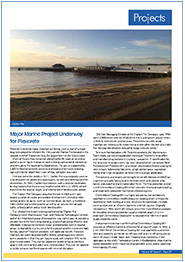Flexcrete’s concrete repair materials are being used as part of a major long-term project to refurbish the 146-year old Clacton Pier located in the seaside resort of Clacton-on-Sea, the largest town on the Essex coast.
Much of the pier has remained untouched for 90 years or so and as part of a seven-figure makeover, work is being carried out to modernise and strengthen the landmark’s infrastructure. The pier is supported by 2,500 reinforced concrete columns and beams which were showing signs of chloride attack from years of tidal salt laden sea water.
First opened to the public in 1871, Clacton Pier was originally used as a landing point for goods and passengers, as well as a docking point for steamships. By 1893, Clacton had become such a popular destination for day trippers that the pier was lengthened to 360 m (1,180 ft), almost three times the original length, and entertainment facilities were added. The Clacton Pier Company acquired the pier in 2009 and it now boasts a variety of indoor and outdoor entertainment, including rides spread across six acres, such as bumper boats, go karts, a traditional helter skelter and a roller coaster, as well as an amusement arcade, cafés, a SeaQuarium and a 10 pin bowling alley.
The refurbishment work is being carried out by Clacton Pier Company’s own Maintenance Team and Flexcrete Technologies Limited, part of the AkzoNobel group of companies, was called upon to provide a solution due to the firm’s long-standing record of providing effective and affordable materials for concrete repair and protection work in coastal areas. Sustainability is a key issue for this project and the environmentally friendly nature of Flexcrete products is of particular benefit. Flexcrete materials are water-based and offer distinct advantages over solvent borne products, in that they are easy to apply with ultra-low VOC levels and minimal odour. They can be applied in public areas or confined spaces with minimal disruption and minimal odour. They can be applied in public areas or confined spaces with minimal disruption.
Complete Concrete Repair & Protection System
Billy Ball, Managing Director of the Clacton Pier Company said, “With some 2,500 columns to be refurbished, this is a long-term project which is likely to extend over several years. Flexcrete’s concrete repair materials are helping us to modernise and strengthen the pier and make the 146-year-old structure relevant to today’s leisure needs.”
To ensure familiarisation with Flexcrete products, the Maintenance Team initially carried out application training at Flexcrete’s head office and manufacturing complex in Leyland, Lancashire. A specification for the structural renovation work has been devised which comprises Steel Reinforcement Protector 841, a corrosion preventative flexible coating for steel re-bars, followed by Monomix, a high performance, waterproof mortar which can be applied up to 80 mm in a single application.
The columns and beams are being finished with Monolevel 844SP, an engineering quality fairing coat to reinstate cover and provide a fair faced, waterproof and anti-carbonation finish. The final protection overall is with Cementitious Coating 851 which provides structural waterproofing and importantly protection from future chloride ingress.
Cementitious Coating 851 is a highly advanced, two component, waterborne cementitious modified polymer coating which is frequently specified on both existing and new structures to waterproof, reinstate cover and provide an effective barrier to chloride ingress. Originally introduced in 1985, and it still remains one of the most effective products for providing structural protection against chloride attack. A 2 mm coating of Cementitious Coating 851 is equivalent to 100 mm of good quality concrete cover.
Independent tests have confirmed that Cementitious Coating 851 provides an effective barrier to chlorides for at least 29 years. In 1988, a 2 mm thick film of Cementitious Coating 851 was applied to a concrete slice and sealed in a chloride ion diffusion cell and it is still going strong some 29 years (10,586 days) later. Ongoing tests carried out in the laboratory at the VINCI Technology Centre in Bedfordshire show that the barrier properties of 851 have not changed after a test period spanning the on-going 29 years.
Read the article published in Port Engineering Management magazine:



